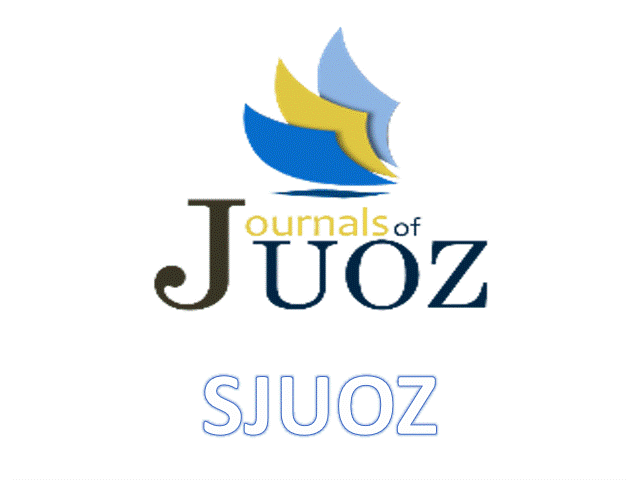Assessment of Monthly Variation of Two Water Bodies in Erbil Governorate.
Keywords:
Principal component analysis, Erbil wastewater channel, Greater Zab River, Water pollutionAbstract
The present study was conducted on Erbil wastewater channel and Greater Zab River. Seven sites were selected, three of them from polluted channel and four from the Greater Zab River. Water samples for chemical and biological analysis were collected monthly from May 2006 to April 2007. Factor analysis (Principal component analysis) revealed six significant main components which represented by more than 64.5% of the total variance, in which explained by 26.13%, 15.73%, 11.92%, 8.33%, 7.36% and 5.85% respectively, it revealed that sewagewater from Erbil city and agricultural activities a round polluted channel were the major source of pollutant in the channel, whereas, for the Greater Zab river the seven PCs, of the total variance, were 23%, 14.63%, 10%, 8.96%, 7.73%, 6.55%, and 6.24% respectively, with 77.14% of a cumulative variance, in which Greater Zab river was polluted by effluent of polluted channel, agricultural activities and mineral erosion through rainfall.
Downloads
References
Allan, J.D. (1995). Stream ecology: Structure and function of running waters. Chapman and Hill, USA. 388pp.
Al-Tamir, M.A. and Al-Sanjari, M.N. (2007). Interpretation of water quality parameters for Tigris River by using principal component analysis. http://www.astf.net/.
Altindag, A. (2000). A toxonomical study on the rotifer found of Yedigoller (Bolu- Turkey). Turk J. Zoology. 24:1- 8.
American Public Health association (A.P.H.A.). (1998). Standard methods for the examination of water and wastewater. 20th.Ed. A.P.H.A., 1015 Fifteenth Street, NW, Washington, DC. 20005-2605.
Arimoro, F.O.; Ikomi, R.B. and Iwegbue, C.M.A. (2007). Water quality changes in relation to Diptera community patterns and diversity measured at an organic effluent impacted stream in the Niger delta, Nigeria. Ecol. Indic., 7: 541- 552.
Banerji, S.K. (1997).Environmental chemistry. Prentice-Hall of India. New Delhi: 160pp.
Bartram, J. and Balance, R. (1996). Water quality monitoring (a practical guide to the design and implementation of freshwater quality studies and monitoring programmes). United Nation Environmental Programme- UNEP- and WHO. E & FN Spon, Chapman and Hall. UK. 383pp.
Best, G.A. and Ross, S.L. (1977). River pollution studies. Liverpool Univ. Press. 92pp.
Bonachela, S.; Acuna, R.A. and Casas, J. (2007). Environmental factors and management practices controlling oxygen dynamics in agricultural irrigation ponds in a semiarid Mediterranean region: Implications for pond agricultural functions. Water Res., 41:1225- 1234.
Cunningham, W.P. and Saigo, B.W. (2001). Environmental Science: A global comcern. 6th.Ed. McGraw-Hill. USA. 646pp.
Dong, J.; Zhang, Y.Y.; Wang, Y.S.; Wa, M.L.; Zhang, S. and Cai, C.H. (2010). Chemometry use in the evaluation of the Sanya bay water quality. Brazilian j. of Oceanogr. 58(4): 339-352.
Edmonson, W.T. (1959). Freshwater biology. 2nd.Ed. John Wiely and Sons, Inc. 1248pp.
Erbil Statistic Directorate (ESD). (2009). Erbil governorate population according to food card. (Archive).
Fataei, E. (2011). Assessment of surface water quality using principal component analysis and factor analysis. World J. of Fish and Marine Sci. 3(2); 159-166.
Feike, M.; Heerkloss, R.; Rieling, T. and Schubert, H. (2007). Studies on the zooplankton community of a shallow lagoon of the southern Baltic sea: Long- term trends, seasonal changes, and relations with physical and chemical parameters. Hydrobiol., 577:95- 106.
Graham, L.E.; Graham, J.M. and Wilcox, L.E. (2006). Plant biology. 2nd.Ed. Pearson Prentice Hall. USA. 670pp.
Hammer, M.J. (1996). Water and wastewater technology. 3rd.Ed. Prentice Hall International, Inc. USA. 519pp.
Hynes, H.B.N. (1960). The biology of polluted waters. Liverpool Univ. Press. UK. 202pp.
Igbinosa, E.O. and Okoh, A.I. (2009). Impact of discharge wastewater effluents on the physico- chemical qualities of receiving watershed in a typical rural community. Int J. of Env. Sci. Tech. 6(2): 175- 182.
Jianqin, M.A.; Jingjing, G. and Xiaojie, L. (2010). Water quality evaluation model based on principal component analysis and information entropy: Application in Jinshui River. J. Resour. Ecol. 1(2): 249- 252.
Jimenz, B. (2006). Irrigation in developing countries using wastewater. Intern. Rev. for Environ. Strategies. 6(2):229- 250.
Kiely, G. (1997). Environmental engineering. Irwin McGraw-Hill. UK. 979pp.
Li, Y.; Xu, L. and Li, S. (2009). Water quality analysis of the Songhua River basin using multivariate techniques. J. of Water Resource and Protection. 2: 110-121.
Liu, W.C.; Yu, H.L. and Chung, C.E. (2011). Assessment of water quality in subtropical Alpine lake using multivariate statistical techniques and geostatistical mapping: A case study. Int. J. Env. Res. And Publ. Health. 8:1126- 1140.
Mohammed, M-B., F.L.S. (1980). A hydrological survey of a polluted canal. Hydrobiology, 74:179- 186.
Ouyang, Y.; Nkedi-Kizza, P.; Wu, Q.T.; Shinde, D. and Huang, C.H. (2006). Assessment of seasonal variatioins in surface water quality. Water Res., 40:3800- 3810.
Pejman, A.H.; Biddhemdi, G.R.; Karbassi, A.R.; Mehrdadi, N. and Bidhendi, M.E. (2009). Evaluation of spatial and seasonal variations in surface water quality using multivariate statistical techniques. Int. J. Env. Sci. Tech. 6(3): 467-476.
Ricklets, R.E. and Miller, G.L. (2000). Ecology. 4th.Ed. W.H. Freeman and Company. USA. 822pp.
Scourfield, D.J. and Harding, J.P. (1966). A key to the British freshwater cladocera, with notes on their ecology. 3rd.Ed. Freshwater biological Association, Science Publication, No.5. 55pp.
Sekabira, K.; Origa, H.O.; Basamba, T.A.; Mutumba, G. and Kakudidi, E. (2010). Heavy metal assessment and water quality values in urban stream and rain water, Int J. of Env. Sci. Tech. 7(4): 759- 770.
Smith, D.G. (2001). Pennak’s freshwater invertebrates of the united States. John Wiely and Sons, Inc. USA. 638pp.
Spanhoff, B.; Bischof, R.; Bohme, A.; Lorenz, S. Neumeister, k.; Nothlich, A. and Kusel, K. (2007). Assessing the impact of effluents from a modern wastewater treatment plant on breakdown of coarse particulate organic matter and benthic macroinvertebrates in a lowland River. Water Air and Soil Pollution. 180:119- 129.
Venkatesharaju, k.; Somaskeker, R.K. and prakash, K.L. (2010). Study of seasonal and spatial variation in surface water quality of Cauvery River stretch in Karnataka. J. of Ecology and the Natural Env. 2(1): 1-9.
Zeng, X. and Rasmussen, T.C. (2005). Multivariate statistical characterization of water quality in lake Lanier, Georgia, UAS. J. of Environmental Quality. 34:1980- 1991.
Downloads
Published
How to Cite
Issue
Section
License
Copyright (c) 2013 Yahya A. Shekha, Jamal K. Al-Abaychi

This work is licensed under a Creative Commons Attribution 4.0 International License.
Authors who publish with this journal agree to the following terms:
- Authors retain copyright and grant the journal right of first publication with the work simultaneously licensed under a Creative Commons Attribution License [CC BY-NC-SA 4.0] that allows others to share the work with an acknowledgment of the work's authorship and initial publication in this journal.
- Authors are able to enter into separate, additional contractual arrangements for the non-exclusive distribution of the journal's published version of the work, with an acknowledgment of its initial publication in this journal.
- Authors are permitted and encouraged to post their work online.








